 Facebook
Facebook
 X
X
 Instagram
Instagram
 TikTok
TikTok
 Youtube
Youtube
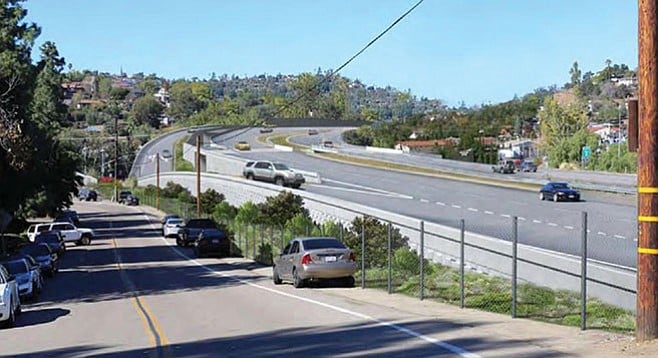
A driver’s November 22, 2016, email to the San Diego Reader asking about “state land for sale” signs, visible to drivers taking State Route 125 through La Mesa just north of State Route 94, led to information about the land and about Caltrans’ plan to build a transition road linking southbound 125 to eastbound 94. Contacted on November 23, the same driver said, “I drove by today, and the signs are down. It’s the area mostly on the east side of 125 just north of Panorama and Echo drives.”
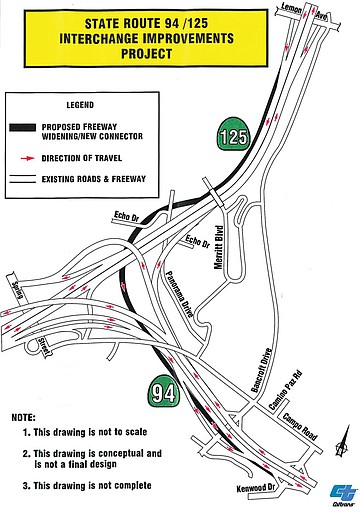
He continued with a description of a nightmarish commute. “That freeway junction creates awful bottlenecks and street traffic on southbound 125’s Spring Street exit backing up onto the freeway. [It’s] very dangerous. Traffic gets off 125 south at Spring in order to get back on 94 east, because there is no connector road. Sometimes the right line is stopped while the lane next to it is going full speed.”
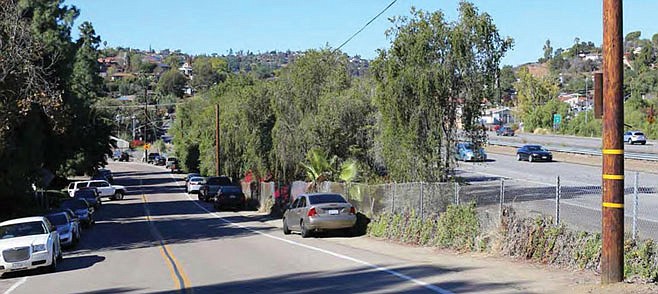
The driver wrote the day before Thanksgiving, and online research yielded the City of La Mesa web page titled “Caltrans State Route 94/State Route 125 Connector Project.” The project goal “is to improve traffic movement from southbound SR-125 to eastbound SR-94 by building a south-to-east connector. The project includes a new freeway connector that will exit southbound SR-125 and connect with eastbound SR-94 near Bancroft Drive,” according to the page with links to pertinent documents.
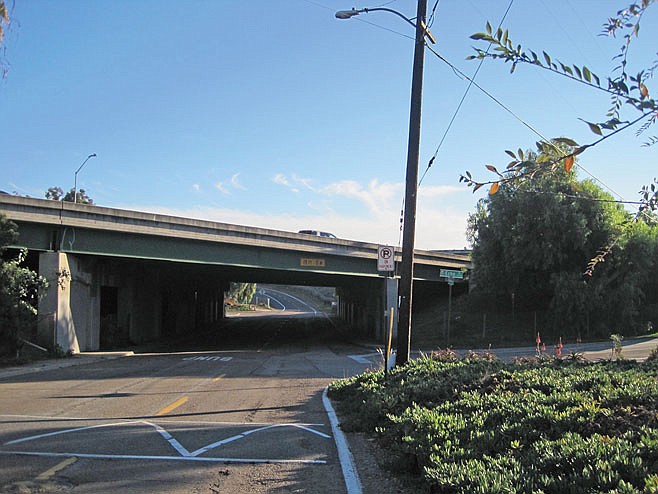
Online searching didn’t provide an answer for the sign-spotting driver, but there was information related to his commute in the January 2016 “State Route 94/SR-125 Interchange Project Fact Sheet” from Caltrans. “The portion of southbound 125 between [the] Lemon Avenue onramp and the Spring Street offramp carries approximately 83,400 vehicles per day.” An average of 20,550 vehicles per day exit at Spring Street, and the project is expected to reduce traffic volume “exiting from southbound 125 at Spring Street by more than 15,000 vehicles per day.”
The project encompasses two miles, with the freeway-to-freeway connector passing under the existing 125 and joining eastbound 94 between Bancroft and Kenwood drives, according to the fact sheet. Construction of two auxiliary lanes is planned: one lane along southbound 125 from Lemon Avenue to the connector and the other lane from the connector to Kenwood Drive.
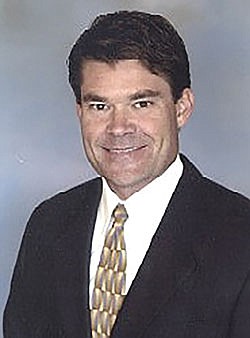
Other proposed improvements include replacing the Mariposa Street overcrossing, widening the State Route 94 bridges over Bancroft Drive, constructing “bridge structures” on Panorama Drive and Echo Drive over the connector, and constructing noise barriers along 94 and 125.
The estimated project cost totaled $71.33 million, with $5 million coming from the State Transportation Congestion Relief Program and $1.7 million in TransNet funds from the San Diego Association of Governments (SANDAG) for environmental studies. (“TransNet,” says SANDAG’s website, “is the half-cent sales tax for local transportation projects that was first approved by voters in 1988, and extended in 2004 for another 40 years.”) However, “construction of these improvements will be scheduled as funding becomes available.”
Missing from the 2016 fact sheet was the timeline on the July 2014 fact sheet. It stated the environmental phase “for the near-term project is scheduled to be complete in August 2015. Construction could begin as early as 2018 and would take about two years to complete.”
As for the “for sale” signs, City of La Mesa senior planner Chris Jacobs said November 28 that Caltrans held a public auction on November 9 at the District 11 office in Old Town. The district serves San Diego and Imperial counties, and the auction brochure said the state agency was selling a 1965-square-foot, three-bedroom, two-bathroom house located on a 15,298-square-foot lot at 8895 Bowling Green Drive in La Mesa. The minimum bid was $380,000 and the property would be sold “as is.”
The house was built in 1957, and Caltrans acquired the property in 1971, spokesman Hayden Manning said on December 7. At the Nov. 9 auction, a $7500 bidder deposit was required. “Fifteen people signed in; only one person bid,” Manning said. That person paid the full bid price before the December 8 deadline, and approval of the agreement is on the California Transportation Commission January 18 agenda. Information about the sale price and bidder’s identity won’t be made public until the agreement is recorded in February, Manning said.
Bowling Green, Echo, and Panorama drives are in the vicinity of State Route 125 where the connector project is proposed, according to maps in the final initial study dated December 31, 2015. The study included a report with comments made at a July 28, 2015, public hearing and Caltrans responses. Topics at the meeting held in La Mesa included several homeowners’ concerns about property values. “I’m concerned that the value of my home will be drastically affected as I am possibly going to sell my home soon,” a Mariposa Street resident wrote on a comment card.
Caltrans responded, “Property value impacts are dynamic and not easily quantified. Negative impacts, such as increased noise or negative visual effects, are not expected to adversely affect the areas adjacent to the 94/125 interchange project. A more efficient transportation system in the area could possibly increase the potential marketability of adjacent properties.”
Two people asked if Caltrans could install lights on the underpass of the existing Panorama Drive bridge. “It’s pitch dark there at night, and so it brings trouble,” a resident said. “It brings garbage, illegally dumped garbage and graffiti, and the homeless that live under the bridge as well.”
Caltrans responded, “Thank you for bringing this issue to our attention. During the final design stage, we will consider the feasibility of adding lighting under both the existing and the proposed bridges.”
The San Diego Reader on December 12 asked Caltrans project manager Lou Melendez about the status of the project. “We stopped the project when we ran out of money.” He said Caltrans funds ran out in 2015, and the project was “put on a shelf.”
Asked when work might begin, Melendez said there was no funding because the SANDAG-sponsored Measure A failed in November. In the year “2021, things might improve,” he said, and he named two programs: the State Highway Operation and Protection Program and the State Transportation Improvement Program.
Melendez spoke more about a third possibility, the Traffic Congestion Relief Program. He said Caltrans decided to break funding for that program into two categories: Tier 1, projects slated for funding and close to design; and Tier 2, which Caltrans hopes “to tap into,” though the “legislature is not inclined” to approve funding.
According to the June 29–30, 2016, California Transportation Commission agenda, “Tier 1 included projects that had a higher priority for funding and Tier 2 included all remaining projects. The remaining Tier 2 projects included those with Traffic Congestion Relief Program funds and those that were not yet fully programmed.”
Melendez again mentioned Measure A and suggested asking SANDAG about other funding. Measure A, the “San Diego County Road Repair, Transit, Traffic Relief, Safety, and Water Quality Measure,” required approval by two-thirds of voters to raise the sales tax by a half-cent for 40 years. But on November 8, county voters rejected the measure.
Asked how approval of Measure A would have affected the interchange project and whether SANDAG had identified other funding sources, spokeswoman Helen Gao wrote in a December 15 email that she would respond “as soon as I can track down info.” She had not responded by press time.
The City of La Mesa is aware of the project status, and that it is awaiting funding, said Greg Humora, the La Mesa public works director/city engineer whose promotion to assistant city manager was announced at the December 13 city-council meeting. On December 15, Humora said the 125/94 is the “number one interchange project in the county” and identified by “TransNet as a high-priority project.”
Meanwhile, Caltrans will have one less item to consider when the project resumes. Humora said LED wall pack lights will be installed underneath the Panorama Drive bridge next year. The project cost is estimated at $50,000, which will include “probably eight lights,” he said. “People have been asking [for lighting] for a long time.”
Lighting was requested by a Panorama Drive resident at the January 15, 2013, City of La Mesa town-hall meeting. The resident spoke of “crime, graffiti, and illegal dumping in the area around the bridge.” In addition, to “a homeless person living under the bridge, there were coyotes attacking animals and following people in the area,” according to the meeting minutes.
Furthermore, the driver who contacted the San Diego Reader could see more “for sale” signs. A December 19 check of the Caltrans website showed the announcement of a February 6 sealed-bid auction. Up for bid is a duplex located at 4271/4273 Panorama Drive. According to the brochure, the minimum bid is $375,000 for the 10,994-square-foot lot with “access on Bowling Green Drive.” The 1052-square-foot home has three bedrooms and one bath. The other unit is 951 square feet and has two bedrooms and one bath.


A driver’s November 22, 2016, email to the San Diego Reader asking about “state land for sale” signs, visible to drivers taking State Route 125 through La Mesa just north of State Route 94, led to information about the land and about Caltrans’ plan to build a transition road linking southbound 125 to eastbound 94. Contacted on November 23, the same driver said, “I drove by today, and the signs are down. It’s the area mostly on the east side of 125 just north of Panorama and Echo drives.”

He continued with a description of a nightmarish commute. “That freeway junction creates awful bottlenecks and street traffic on southbound 125’s Spring Street exit backing up onto the freeway. [It’s] very dangerous. Traffic gets off 125 south at Spring in order to get back on 94 east, because there is no connector road. Sometimes the right line is stopped while the lane next to it is going full speed.”

The driver wrote the day before Thanksgiving, and online research yielded the City of La Mesa web page titled “Caltrans State Route 94/State Route 125 Connector Project.” The project goal “is to improve traffic movement from southbound SR-125 to eastbound SR-94 by building a south-to-east connector. The project includes a new freeway connector that will exit southbound SR-125 and connect with eastbound SR-94 near Bancroft Drive,” according to the page with links to pertinent documents.

Online searching didn’t provide an answer for the sign-spotting driver, but there was information related to his commute in the January 2016 “State Route 94/SR-125 Interchange Project Fact Sheet” from Caltrans. “The portion of southbound 125 between [the] Lemon Avenue onramp and the Spring Street offramp carries approximately 83,400 vehicles per day.” An average of 20,550 vehicles per day exit at Spring Street, and the project is expected to reduce traffic volume “exiting from southbound 125 at Spring Street by more than 15,000 vehicles per day.”
The project encompasses two miles, with the freeway-to-freeway connector passing under the existing 125 and joining eastbound 94 between Bancroft and Kenwood drives, according to the fact sheet. Construction of two auxiliary lanes is planned: one lane along southbound 125 from Lemon Avenue to the connector and the other lane from the connector to Kenwood Drive.

Other proposed improvements include replacing the Mariposa Street overcrossing, widening the State Route 94 bridges over Bancroft Drive, constructing “bridge structures” on Panorama Drive and Echo Drive over the connector, and constructing noise barriers along 94 and 125.
The estimated project cost totaled $71.33 million, with $5 million coming from the State Transportation Congestion Relief Program and $1.7 million in TransNet funds from the San Diego Association of Governments (SANDAG) for environmental studies. (“TransNet,” says SANDAG’s website, “is the half-cent sales tax for local transportation projects that was first approved by voters in 1988, and extended in 2004 for another 40 years.”) However, “construction of these improvements will be scheduled as funding becomes available.”
Missing from the 2016 fact sheet was the timeline on the July 2014 fact sheet. It stated the environmental phase “for the near-term project is scheduled to be complete in August 2015. Construction could begin as early as 2018 and would take about two years to complete.”
As for the “for sale” signs, City of La Mesa senior planner Chris Jacobs said November 28 that Caltrans held a public auction on November 9 at the District 11 office in Old Town. The district serves San Diego and Imperial counties, and the auction brochure said the state agency was selling a 1965-square-foot, three-bedroom, two-bathroom house located on a 15,298-square-foot lot at 8895 Bowling Green Drive in La Mesa. The minimum bid was $380,000 and the property would be sold “as is.”
The house was built in 1957, and Caltrans acquired the property in 1971, spokesman Hayden Manning said on December 7. At the Nov. 9 auction, a $7500 bidder deposit was required. “Fifteen people signed in; only one person bid,” Manning said. That person paid the full bid price before the December 8 deadline, and approval of the agreement is on the California Transportation Commission January 18 agenda. Information about the sale price and bidder’s identity won’t be made public until the agreement is recorded in February, Manning said.
Bowling Green, Echo, and Panorama drives are in the vicinity of State Route 125 where the connector project is proposed, according to maps in the final initial study dated December 31, 2015. The study included a report with comments made at a July 28, 2015, public hearing and Caltrans responses. Topics at the meeting held in La Mesa included several homeowners’ concerns about property values. “I’m concerned that the value of my home will be drastically affected as I am possibly going to sell my home soon,” a Mariposa Street resident wrote on a comment card.
Caltrans responded, “Property value impacts are dynamic and not easily quantified. Negative impacts, such as increased noise or negative visual effects, are not expected to adversely affect the areas adjacent to the 94/125 interchange project. A more efficient transportation system in the area could possibly increase the potential marketability of adjacent properties.”
Two people asked if Caltrans could install lights on the underpass of the existing Panorama Drive bridge. “It’s pitch dark there at night, and so it brings trouble,” a resident said. “It brings garbage, illegally dumped garbage and graffiti, and the homeless that live under the bridge as well.”
Caltrans responded, “Thank you for bringing this issue to our attention. During the final design stage, we will consider the feasibility of adding lighting under both the existing and the proposed bridges.”
The San Diego Reader on December 12 asked Caltrans project manager Lou Melendez about the status of the project. “We stopped the project when we ran out of money.” He said Caltrans funds ran out in 2015, and the project was “put on a shelf.”
Asked when work might begin, Melendez said there was no funding because the SANDAG-sponsored Measure A failed in November. In the year “2021, things might improve,” he said, and he named two programs: the State Highway Operation and Protection Program and the State Transportation Improvement Program.
Melendez spoke more about a third possibility, the Traffic Congestion Relief Program. He said Caltrans decided to break funding for that program into two categories: Tier 1, projects slated for funding and close to design; and Tier 2, which Caltrans hopes “to tap into,” though the “legislature is not inclined” to approve funding.
According to the June 29–30, 2016, California Transportation Commission agenda, “Tier 1 included projects that had a higher priority for funding and Tier 2 included all remaining projects. The remaining Tier 2 projects included those with Traffic Congestion Relief Program funds and those that were not yet fully programmed.”
Melendez again mentioned Measure A and suggested asking SANDAG about other funding. Measure A, the “San Diego County Road Repair, Transit, Traffic Relief, Safety, and Water Quality Measure,” required approval by two-thirds of voters to raise the sales tax by a half-cent for 40 years. But on November 8, county voters rejected the measure.
Asked how approval of Measure A would have affected the interchange project and whether SANDAG had identified other funding sources, spokeswoman Helen Gao wrote in a December 15 email that she would respond “as soon as I can track down info.” She had not responded by press time.
The City of La Mesa is aware of the project status, and that it is awaiting funding, said Greg Humora, the La Mesa public works director/city engineer whose promotion to assistant city manager was announced at the December 13 city-council meeting. On December 15, Humora said the 125/94 is the “number one interchange project in the county” and identified by “TransNet as a high-priority project.”
Meanwhile, Caltrans will have one less item to consider when the project resumes. Humora said LED wall pack lights will be installed underneath the Panorama Drive bridge next year. The project cost is estimated at $50,000, which will include “probably eight lights,” he said. “People have been asking [for lighting] for a long time.”
Lighting was requested by a Panorama Drive resident at the January 15, 2013, City of La Mesa town-hall meeting. The resident spoke of “crime, graffiti, and illegal dumping in the area around the bridge.” In addition, to “a homeless person living under the bridge, there were coyotes attacking animals and following people in the area,” according to the meeting minutes.
Furthermore, the driver who contacted the San Diego Reader could see more “for sale” signs. A December 19 check of the Caltrans website showed the announcement of a February 6 sealed-bid auction. Up for bid is a duplex located at 4271/4273 Panorama Drive. According to the brochure, the minimum bid is $375,000 for the 10,994-square-foot lot with “access on Bowling Green Drive.” The 1052-square-foot home has three bedrooms and one bath. The other unit is 951 square feet and has two bedrooms and one bath.
Comments